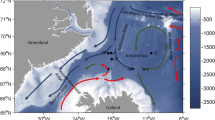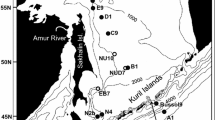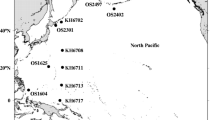Abstract
The main emphasis of this study was to analyse the short-term development of abundance, population structure and vertical distribution of the dominant calanoid copepods during a phytoplankton bloom in the coastal area of the eastern Weddell Sea in December 2003. Microcalanus pygmaeus was by far the most abundant calanoid species. Metridia gerlachei, Ctenocalanus citer, Calanoides acutus, Calanus propinquus and the ice-associated Stephos longipes were also present in considerable proportions. The observed changes in the population characteristics and parameters of these species are described in detail and discussed in the context of the spring phytoplankton bloom. A conspicuous event occurring during the final stage of the study was the development of a strong storm. While the results suggest that this storm did not have any considerable influence on the populations of all other investigated copepod species, it very likely caused pronounced changes in the S. longipes population present in the water column. Before the storm, S. longipes was found primarily in the upper 100 m of the water column, and its population was dominated by adults (mean proportion = 41%) and the copepodite stage I (mean proportion = 30%). After the storm, the abundance increased considerably, and the copepodite stage I contributed by far the largest proportion (53%) of the total population indicating that the early copepodite stages probably had been released from the sea ice into the under ice water layer due to ice break-up and ice melt processes caused by the storm.













Similar content being viewed by others
References
Atkinson A (1991) Life cycles of Calanoides acutus, Calanus simillimus and Rhincalanus gigas (Copepoda: Calanoida) within the Scotia Sea. Mar Biol 109:79–91
Atkinson A (1998) Life cycle strategies of epipelagic copepods in the Southern Ocean. J Mar Sys 15:289–311
Atkinson A, Schnack-Schiel SB, Ward P, Marin V (1997) Regional differences in the life cycle of Calanoides acutus (Copepoda: Calanoida) within the Atlantic sector of the Southern Ocean. Mar Ecol Prog Ser 150:99–111
Bathmann UV, Makarov RR, Spiridonov VA, Rohardt G (1993) Winter distribution and overwintering strategies of the Antarctic copepod species Calanoides acutus, Rhincalanus gigas and Calanus propinquus (Crustacea, Calanoida) in the Weddell Sea. Polar Biol 13:333–346
Bollens SM, Frost BW (1989) Predator-induced diel vertical migration in a planktonic copepod. J Plankton Res 11:1047–1065
Carpenter LJ, Wevill DJ, Palmer CJ, Michels J (2007) Depth profiles of volatile iodine and bromine-containing halocarbons in coastal Antarctic waters. Mar Chem 103:227–236
Cisewski B, Strass VH, Prandke H (2005) Upper ocean vertical mixing in the Antarctic Polar Front Zone. Deep-Sea Res II 52:1087–1108
Eicken H (1992) The role of sea ice in structuring Antarctic ecosystems. Polar Biol 12:3–13
Fransz HG (1988) Vernal abundance, structure and development of epipelagic copepod populations of the eastern Weddell Sea, Antarctica. Polar Biol 9:107–114
Guglielmo L, Zagami G, Saggiomo V, Catalano G, Granata A (2007) Copepods in spring annual sea ice at Terra Nova Bay (Ross Sea, Antarctica). Polar Biol 30:747–758
Hagen W, Schnack-Schiel SB (1996) Seasonal lipid dynamics in dominant Antarctic copepods: energy for overwintering or reproduction? Deep-Sea Res 43:139–158
Hopkins TL (1985) Food web of an Antarctic midwater ecosystem. Mar Biol 89:197–212
Hopkins TL, Torres JJ (1989) Midwater food web in the vicinity of a marginal ice zone in the western Weddell Sea. Deep-Sea Res 36:543–560
Hopkins TL, Ainley DG, Torres JJ, Lancraft TM (1993a) Trophic structure in open waters of the marginal ice zone in the Scotia-Weddell confluence region during spring (1983). Polar Biol 13:389–397
Hopkins TL, Lancraft TM, Torres JJ, Donnelly J (1993b) Community structure and trophic ecology of zooplankton in the Scotia Sea marginal ice zone in winter (1988). Deep-Sea Res 40:81–105
Huntley ME, Escritor F (1992) Ecology of Metridia gerlachei Giesbrecht in the western Bransfield Strait, Antarctica. Deep-Sea Res 39:1027–1055
Jeffrey SW, Humphrey GF (1975) New spectrophotometric equations for determining chlorophylls a, b, c1 and c2 in higher plants, algae and natural phytoplankton. Biochem Physiol Pflanz 167:191–194
Kurbjeweit F (1993) Reproduktion und Lebenszyklen dominanter Copepodenarten aus dem Weddellmeer, Antarktis. Ber Polarforsch 129, Alfred Wegener Institute for Polar and Marine Research, Bremerhaven, 238 pp
Kurbjeweit F, Gradinger R, Weissenberger J (1993) The life cycle of Stephos longipes–an example for cryopelagic coupling in the Weddell Sea (Antarctica). Mar Ecol Prog Ser 98:255–262
Laubscher RK, Perissinotto R, McQuaid CD (1993) Phytoplankton production and biomass at frontal zones in the Atlantic sector of the Southern Ocean. Polar Biol 13:471–481
Marin V (1987) The oceanographic structure of the eastern Scotia Sea–IV. Distribution of copepod species in relation to hydrography in 1981. Deep-Sea Res 34:105–121
Marin V (1988) Qualitative models of the life cycles of Calanoides acutus, Calanus propinquus and Rhincalanus gigas. Polar Biol 8:439–446
Menden-Deuer S, Lessard EJ (2000) Carbon to volume relationships for dinoflagellates, diatoms, and other protist plankton. Limnol Oceanogr 45:569–579
Metz C (1996) Lebensstrategien dominanter antarktischer Oithonidae (Cyclopoida, Copepoda) und Oncaeidae (Poecilostomatoida, Copepoda) im Bellingshausenmeer. Ber Polarforsch 207, Alfred Wegener Institute for Polar and Marine Research, Bremerhaven, 123 pp
Metz C, Schnack-Schiel SB (1995) Observations on carnivorous feeding in Antarctic calanoid copepods. Mar Ecol Prog Ser 129:71–75
Michels J, Schnack-Schiel SB (2005) Feeding in dominant Antarctic copepods—does the morphology of the mandibular gnathobases relate to diet? Mar Biol 146:483–495
Niehoff B, Schnack-Schiel S, Cornils A, Brichta M (2002) Reproductive activity of two dominant Antarctic copepod species, Metridia gerlachei and Ctenocalanus citer, in late autumn in the eastern Bellingshausen Sea. Polar Biol 25:583–590
Nöthig E-M, Bathmann U, Jennings JC, Fahrbach E, Gradinger R, Gordon LI, Makarov R (1991) Regional relationships between biological and hydrological properties in the Weddell Sea Gyre in late austral winter 1989. Mar Chem 35:325–336
Pasternak AF, Schnack-Schiel SB (2001a) Feeding patterns of dominant Antarctic copepods: an interplay of diapause, selectivity, and availability of food. Hydrobiologia 453/454:25–36
Pasternak AF, Schnack-Schiel SB (2001b) Seasonal feeding patterns of the dominant Antarctic copepods Calanus propinquus and Calanoides acutus in the Weddell Sea. Polar Biol 24:771–784
Pasternak AF, Schnack-Schiel SB (2007) Feeding of Ctenocalanus citer in the eastern Weddell Sea: low in summer and spring, high in autumn and winter. Polar Biol 30:493–501
Scharek R, Smetacek V, Fahrbach E, Gordon LI, Rohardt G, Moore S (1994) The transition from winter to early spring in the eastern Weddell Sea, Antarctica: plankton biomass and composition in relation to hydrography and nutrients. Deep-Sea Res 41:1231–1250
Schnack-Schiel SB (2001) Aspects of the study of the life cycles of Antarctic copepods. Hydrobiologia 453/454:9–24
Schnack-Schiel SB, Hagen W (1994) Life cycle strategies and seasonal variations in distribution and population structure of four dominant calanoid copepod species in the eastern Weddell Sea, Antarctica. J Plankton Res 16:1543–1566
Schnack-Schiel SB, Hagen W (1995) Life-cycle strategies of Calanoides acutus, Calanus propinquus and Metridia gerlachei (Copepoda: Calanoida) in the eastern Weddell Sea, Antarctica. ICES J Mar Sci 52:541–548
Schnack-Schiel SB, Mizdalski E (1994) Seasonal variations in distribution and population structure of Microcalanus pygmaeus and Ctenocalanus citer (Copepoda: Calanoida) in the eastern Weddell Sea, Antarctica. Mar Biol 119:357–366
Schnack-Schiel SB, Hagen W, Mizdalski E (1991) Seasonal comparison of Calanoides acutus and Calanus propinquus (Copepoda: Calanoida) in the southeastern Weddell Sea, Antarctica. Mar Ecol Prog Ser 70:17–27
Schnack-Schiel SB, Thomas D, Dieckmann GS, Eicken H, Gradinger R, Spindler M, Weissenberger J, Mizdalski E, Beyer K (1995) Life cycle strategy of the Antarctic calanoid copepod Stephos longipes. Prog Oceanogr 36:45–75
Schnack-Schiel SB, Thomas DN, Dahms H-U, Haas C, Mizdalski E (1998) Copepods in Antarctic sea ice. In: Lizotte M, Arrigo K (eds) Antarctic Sea Ice: Biological Processes, Interactions and Variability, vol 73. American Geophysical Union, Antarctic Research Series, pp 173–182
Schnack-Schiel SB, Thomas DN, Haas C, Dieckmann GS, Alheit R (2001) The occurrence of the copepods Stephos longipes (Calanoida) and Drescheriella glacialis (Harpacticoida) in summer sea ice in the Weddell Sea, Antarctica. Antarct Sci 13:150–157
Schnack-Schiel SB, Haas C, Michels J, Mizdalski E, Schünemann H, Steffens M, Thomas DN (2008a) Copepods in sea ice of the western Weddell Sea during austral spring 2004. Deep-Sea Res II 55:1056–1067
Schnack-Schiel SB, Michels J, Mizdalski E, Schodlok MP, Schröder M (2008b) Composition and community structure of zooplankton in the sea ice covered western Weddell Sea in spring 2004—with emphasis on calanoid copepods. Deep-Sea Res II 55:1040–1055
Spiridonov VA, Kosobokova KN (1997) Overwintering stages, the onset of gonad development, and winter ontogenetic migrations in large dominant calanoid copepods in the Weddell Gyre (Antarctica). Mar Ecol Prog Ser 157:233–246
Swadling KM, Kawaguchi S, Hosie GW (2010) Antarctic mesozooplankton community structure during BROKE-West (30°E–80°E), January–February 2006. Deep-Sea Res II 57:887–904
Tréguer P, Jacques G (1992) Dynamics of nutrients and phytoplankton, and fluxes of carbon, nitrogen and silicon in the Antarctic Ocean. Polar Biol 12:149–162
Utermöhl H (1958) Zur Vervollkommnung der quantitativen Phytoplankton-Methodik. Mitt Intern Verein Limnol 9:1–38
Żmijewska MI, Bielecka L, Grabowska A (1999) The time-space variability of copepoda from the Pseudocalanidae family in Croker Passage (Antarctic Peninsula). Oceanol Stud 28:75–84
Żmijewska MI, Bielecka L, Grabowska A (2000) Seasonal and diel changes in the vertical distribution in relation to the age structure of Microcalanus pygmaeus Sars and Ctenocalanus citer Bowman & Heron, (Pseudocalanidae, Copepoda) from Croker Passage (Antarctica). Oceanologia 42:89–103
Acknowledgments
The authors gratefully acknowledge the help of the captain, the officers and the crew of RV “Polarstern” and the colleagues participating in the expedition ANT XXI/2. Tatjana Ratkova determined and counted the phytoplankton. Thomas Brey helped with the correlation model. Boris Cisewski calculated the mixed layer depth and created the raw version of Fig. 3. Anna Kop and Ruth Alheit made the linguistic revision of the manuscript. Anna Pasternak was partly supported by a stipend from the Hanse-Wissenschaftskolleg, RFBR project 07-04-00029, and the Alfred-Wegener-Institut.
Author information
Authors and Affiliations
Corresponding author
Rights and permissions
About this article
Cite this article
Michels, J., Schnack-Schiel, S.B., Pasternak, A. et al. Abundance, population structure and vertical distribution of dominant calanoid copepods on the eastern Weddell Sea shelf during a spring phytoplankton bloom. Polar Biol 35, 369–386 (2012). https://doi.org/10.1007/s00300-011-1083-1
Received:
Accepted:
Published:
Issue Date:
DOI: https://doi.org/10.1007/s00300-011-1083-1




